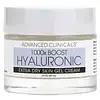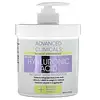What's inside
What's inside
 Key Ingredients
Key Ingredients

 Benefits
Benefits

 Concerns
Concerns

 Ingredients Side-by-side
Ingredients Side-by-side

Water
Skin ConditioningPropanediol
SolventDimethicone
EmollientGlycerin
HumectantPyrus Malus Fruit Extract
Skin ConditioningAmmonium Acryloyldimethyltaurate/Vp Copolymer
Sodium Hyaluronate
HumectantAloe Barbadensis Leaf Juice
Skin ConditioningDipotassium Glycyrrhizate
HumectantButylene Glycol
HumectantCaulerpa Lentillifera Extract
Oryza Sativa Bran Extract
Skin ConditioningRosmarinus Officinalis Leaf Extract
AntimicrobialHelianthus Annuus Extract
EmollientCymbopogon Martini Oil
MaskingCyanocobalamin
Skin ConditioningHydroxyethylcellulose
Emulsion StabilisingSea Salt
AbrasiveCarrageenan
Vaccinium Angustifolium Fruit Extract
Skin ProtectingAscorbic Acid
AntioxidantPolysorbate 20
EmulsifyingRosa Centifolia Flower Extract
AstringentPhenoxyethanol
PreservativeTocopherol
AntioxidantMaltodextrin
AbsorbentTetrasodium Glutamate Diacetate
Caprylyl Glycol
EmollientEthylhexylglycerin
Skin ConditioningSodium Hydroxide
BufferingHexylene Glycol
EmulsifyingCitric Acid
BufferingWater, Propanediol, Dimethicone, Glycerin, Pyrus Malus Fruit Extract, Ammonium Acryloyldimethyltaurate/Vp Copolymer, Sodium Hyaluronate, Aloe Barbadensis Leaf Juice, Dipotassium Glycyrrhizate, Butylene Glycol, Caulerpa Lentillifera Extract, Oryza Sativa Bran Extract, Rosmarinus Officinalis Leaf Extract, Helianthus Annuus Extract, Cymbopogon Martini Oil, Cyanocobalamin, Hydroxyethylcellulose, Sea Salt, Carrageenan, Vaccinium Angustifolium Fruit Extract, Ascorbic Acid, Polysorbate 20, Rosa Centifolia Flower Extract, Phenoxyethanol, Tocopherol, Maltodextrin, Tetrasodium Glutamate Diacetate, Caprylyl Glycol, Ethylhexylglycerin, Sodium Hydroxide, Hexylene Glycol, Citric Acid
Water
Skin ConditioningCetearyl Alcohol
EmollientParaffinum Liquidum
EmollientGlyceryl Stearate Se
EmulsifyingCocos Nucifera Oil
MaskingIsopropyl Myristate
EmollientGlycerin
HumectantButylene Glycol
HumectantCeteareth-20
CleansingButyrospermum Parkii Butter
Skin ConditioningCaprylic/Capric Triglyceride
MaskingAloe Barbadensis Leaf Juice
Skin ConditioningChondrus Crispus Extract
Skin ConditioningSodium Hyaluronate
HumectantSqualene
EmollientTocopheryl Acetate
AntioxidantBorago Officinalis Seed Oil
EmollientPunica Granatum Seed Oil
EmollientLimnanthes Alba Seed Oil
Skin ConditioningPanthenol
Skin ConditioningDisodium EDTA
Ceramide Ns
Skin ConditioningParfum
MaskingAcrylates/C10-30 Alkyl Acrylate Crosspolymer
Emulsion StabilisingPhenoxyethanol
PreservativeCaprylyl Glycol
EmollientEthylhexylglycerin
Skin ConditioningHexylene Glycol
EmulsifyingSodium Hydroxide
BufferingWater, Cetearyl Alcohol, Paraffinum Liquidum, Glyceryl Stearate Se, Cocos Nucifera Oil, Isopropyl Myristate, Glycerin, Butylene Glycol, Ceteareth-20, Butyrospermum Parkii Butter, Caprylic/Capric Triglyceride, Aloe Barbadensis Leaf Juice, Chondrus Crispus Extract, Sodium Hyaluronate, Squalene, Tocopheryl Acetate, Borago Officinalis Seed Oil, Punica Granatum Seed Oil, Limnanthes Alba Seed Oil, Panthenol, Disodium EDTA, Ceramide Ns, Parfum, Acrylates/C10-30 Alkyl Acrylate Crosspolymer, Phenoxyethanol, Caprylyl Glycol, Ethylhexylglycerin, Hexylene Glycol, Sodium Hydroxide
Ingredients Explained
These ingredients are found in both products.
Ingredients higher up in an ingredient list are typically present in a larger amount.
Aloe Barbadensis Leaf Juice comes from leaves of the aloe plant. Aloe Barbadensis Leaf Juice is best known for helping to soothe sunburns. It is also anti-inflammatory, moisturizing, antiseptic, and can help heal wounds.
Aloe is packed with good stuff including Vitamins A, C, and E. These vitamins are antioxidants, which help fight free-radicals and the damage they may cause. Free-radicals are molecules that may damage your skin cells, such as pollution.
Aloe Barbadensis Leaf Juice also contains sugars. These sugars come in the form of monosaccharides and polysaccharides, folic acid, and choline. These sugars are able to help bind moisture to skin.
It also contains minerals such as calcium, 12 anthraquinones, fatty acids, amino acids, and Vitamin B12.
Learn more about Aloe Barbadensis Leaf JuiceButylene Glycol (or BG) is used within cosmetic products for a few different reasons:
Overall, Butylene Glycol is a safe and well-rounded ingredient that works well with other ingredients.
Though this ingredient works well with most skin types, some people with sensitive skin may experience a reaction such as allergic rashes, closed comedones, or itchiness.
Learn more about Butylene GlycolCaprylyl Glycol is a humectant and emollient, meaning it attracts and preserves moisture.
It is a common ingredient in many products, especially those designed to hydrate skin. The primary benefits are retaining moisture, skin softening, and promoting a healthy skin barrier.
Though Caprylyl Glycol is an alcohol derived from fatty acids, it is not the kind that can dry out skin.
This ingredient is also used as a preservative to extend the life of products. It has slight antimicrobial properties.
Learn more about Caprylyl GlycolEthylhexylglycerin (we can't pronounce this either) is commonly used as a preservative and skin softener. It is derived from glyceryl.
You might see Ethylhexylglycerin often paired with other preservatives such as phenoxyethanol. Ethylhexylglycerin has been found to increase the effectiveness of these other preservatives.
Glycerin is already naturally found in your skin. It helps moisturize and protect your skin.
A study from 2016 found glycerin to be more effective as a humectant than AHAs and hyaluronic acid.
As a humectant, it helps the skin stay hydrated by pulling moisture to your skin. The low molecular weight of glycerin allows it to pull moisture into the deeper layers of your skin.
Hydrated skin improves your skin barrier; Your skin barrier helps protect against irritants and bacteria.
Glycerin has also been found to have antimicrobial and antiviral properties. Due to these properties, glycerin is often used in wound and burn treatments.
In cosmetics, glycerin is usually derived from plants such as soybean or palm. However, it can also be sourced from animals, such as tallow or animal fat.
This ingredient is organic, colorless, odorless, and non-toxic.
Glycerin is the name for this ingredient in American English. British English uses Glycerol/Glycerine.
Learn more about GlycerinHexylene Glycol is a surfactant. Glycols are a class of alcohols. Hexylene Glycol is a surfactant and emulsifier.
As a surfactant, Hexylene Glycol helps gather dirt and oil on your skin to be washed away.
As an emulsifier, Hexylene Glycol helps keep water and oil together. This prevents them from separating in a product. Hexylene Glycol also thins out the texture of a product by lessening viscosity.
Hexylene Glycol has a small molecular weight.
Learn more about Hexylene GlycolPhenoxyethanol is a preservative that has germicide, antimicrobial, and aromatic properties. Studies show that phenoxyethanol can prevent microbial growth. By itself, it has a scent that is similar to that of a rose.
It's often used in formulations along with Caprylyl Glycol to preserve the shelf life of products.
Sodium Hyaluronate is hyaluronic acid's salt form. It is commonly derived from the sodium salt of hyaluronic acid.
Like hyaluronic acid, it is great at holding water and acts as a humectant. This makes it a great skin hydrating ingredient.
Sodium Hyaluronate is naturally occurring in our bodies and is mostly found in eye fluid and joints.
These are some other common types of Hyaluronic Acid:
Learn more about Sodium HyaluronateSodium Hydroxide is also known as lye or caustic soda. It is used to adjust the pH of products; many ingredients require a specific pH to be effective.
In small amounts, sodium hydroxide is considered safe to use. However, large amounts may cause chemical burns due to its high alkaline.
Your skin has a natural pH and acid mantle. This acid mantle helps prevent harmful bacteria from breaking through. The acid mantle also helps keep your skin hydrated.
"Alkaline" refers to a high pH level. A low pH level would be considered acidic.
Learn more about Sodium HydroxideWater. It's the most common cosmetic ingredient of all. You'll usually see it at the top of ingredient lists, meaning that it makes up the largest part of the product.
So why is it so popular? Water most often acts as a solvent - this means that it helps dissolve other ingredients into the formulation.
You'll also recognize water as that liquid we all need to stay alive. If you see this, drink a glass of water. Stay hydrated!
Learn more about Water